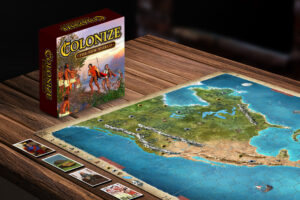
Welcome to another exciting newsletter update, and thank you for your continued interested in our game! Today we are going to take a deeper look into how to play the game! answer some questions that have been sent in.
Whether you’re new to strategy games or a seasoned player, you probably have a few questions about how Colonize: The New World compares to other games—and how it actually plays. Let’s start with a common one:
Q: Is this game like [insert other game here]?
It’s a fair question, and one I’ve heard often. I’ve played a wide range of both tabletop and video games, and like many games in the genre, Colonize: The New World does share a few familiar mechanics and gameplay elements.
That said, this game brings a lot to the table that I haven’t seen elsewhere. It doesn’t just focus on one mechanic like economic strategy, military conflict, or colony-building—it balances all three, while covering the full span of the colonial era. Even the game board map had to be hand-drawn, digitized, and then scaled for gameplay. And thanks to the range of decisions players can make, no two games in playtesting have ever played out the same way.
As far as I can tell, there is no other board game like it on the market.
Q: Can I have a basic breakdown of gameplay?
Yes! While the game might seem complex at first, it becomes much more intuitive after a few rounds. Each turn is divided into five phases, but for much of the game, you’ll only use four. The first and last phases are completed simultaneously by all players, keeping the pace moving quickly.
Let’s walk through what a typical turn looks like in Colonize: The New World.
Phase 1: Upkeep
All players perform the following steps in order:
- Set the Stage: Pass the start token and move the Sea Monster. While the Kraken isn’t real (as far as we know…), it was a real fear as ancient as recorded history. Players can battle this roaming Sea Monster to earn money and gain a powerful Founding Father card.
- Negotiate Treaties: Strike alliances, broker trade deals, or make bold promises with other players. The treaty system is fully open-ended and player-driven—whether you double-cross rivals or channel your inner Benjamin Franklin with brilliant diplomacy is entirely up to you.
- Obey the King: Roll to see if a King card is drawn. These can impose taxes, mandatory declarations of war, or even force you to loudly swear loyalty to His Majesty.
- Indian Raid: If you’ve angered native populations by attacking or building on their land, they may retaliate. The higher your aggression level (from 0 to 5), the more likely a raid becomes.
Phase 2: Movement
Players take turns moving their units based on Movement Points (MP). Each unit type has its own movement rules and limitations.
Phase 3: Action
Each unit may take one action during this phase. Actions include:
- Attack: Battle other players or Indigenous forces (by land)
- Trade with Indians
- Besiege: Launch an attack on an enemy colony (by sea)
- Build Colony: Establish a new colony in an unoccupied area
- Grow Colony: Expand an existing colony
- Generate Colonist: Recruit additional colonists to bolster your population
- Declare Independence: End your Action Phase and trigger your War of Independence from the King (Phase 4)
Phase 4: Independence Phase
This phase only occurs if a player declares independence. The detailed steps and mechanics for this phase will be covered in a future newsletter.
Phase 5: End of Turn
All players perform the following steps in order:
- Receive Building Resources: Collect resources from your colonies and buildings.
- Generate Liberty Bells: Produce Liberty Bells to advance the cause of independence.
- Construct Buildings: Build new structures within your colonies, if building resources allow.
- King’s Market: Buy and sell according to the King’s rules—or, if you’ve built the right infrastructure, from your own colonies.
- Other Players/Indians: Resolve any interactions with other players or Indigenous forces (e.g., if you agreed to pay another player $100, now’s the time).
- Founding Father Cards: Draw and manage Founding Father cards to gain powerful strategic advantages.
A Note on Flow and Pace
Once players are familiar with the rules, Phase 1 (Upkeep) and Phase 5 (End of Turn) can be completed simultaneously to keep things moving quickly. Phases 2–4 follow turn order and must be completed one at a time.
After just a few turns, most players get the hang of the structure. To help keep things organized, each player uses an easy-to-follow laminated player sheet to track progress, actions, and colonies.
More to Explore
🗺️ Check out the game pieces and materials
📸 For more gameplay insight, check out our Instagram reel
🛍️ Want to support the game and grab some merch? Visit our shop
More updates (including a deep dive into the Revolutionary War phase) are on the way soon!
Thanks for being a part of this journey. We can’t wait to bring Colonize: The New World to your table!

